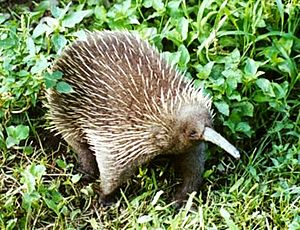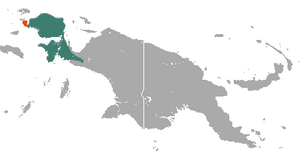Western long-beaked echidna facts for kids
Quick facts for kids Western long-beaked echidna |
|
|---|---|
 |
|
| Conservation status | |
| Scientific classification | |
 |
|
| Western long-beaked echidna range (green — extant, orange — possibly extinct) |
|
| Synonyms | |
|
Zaglossus bruijnii (Peters & Doria, 1876) [orth. error] |
The western long-beaked echidna (Zaglossus bruijni) is a special animal that lives in New Guinea. It's one of the few mammals that lay eggs, just like the Platypus! Scientists have also found old bones (fossils) of this animal in Australia. It is one of four types of echidnas alive today, and three of these are long-beaked echidnas.
Contents
Where They Live and What They Eat
These echidnas live high up in the mountains, from about 1,300 meters to 4,000 meters above the sea level. They like cool, wet places like mountain forests and grassy areas called alpine meadows.
Unlike their cousins, the short-beaked echidnas, which munch on ants and termites, the western long-beaked echidna loves to eat earthworms. They are also bigger than the short-beaked echidnas. You can tell them apart from other long-beaked echidnas by looking at their feet: they usually have three claws on each foot, but sometimes they have four.
Why They Are Special: Egg-Laying Mammals
The western long-beaked echidna, along with other echidnas and the platypus, belongs to a unique group of mammals called monotremes. What makes them so special? They are the only mammals in the world that lay eggs! Most mammals give birth to live babies, but monotremes hatch their young from eggs.
Protecting These Amazing Animals
Sadly, the western long-beaked echidna is an endangered species. This means there are not many of them left in the wild. Their numbers have gone down because their homes are being lost, and because people hunt them.
Even though hunting them is not allowed by the governments of Indonesia and Papua New Guinea, some traditional hunting is still permitted. Protecting these unique animals is very important so they can continue to live in their mountain homes.
In 2006, a group of scientists found a hidden group of these echidnas in a place they called a "lost world" in the Foja Mountains of Papua Province, Indonesia. This discovery gave hope that more of these amazing creatures might be out there.
Images for kids
See also
 In Spanish: Zagloso occidental para niños
In Spanish: Zagloso occidental para niños




